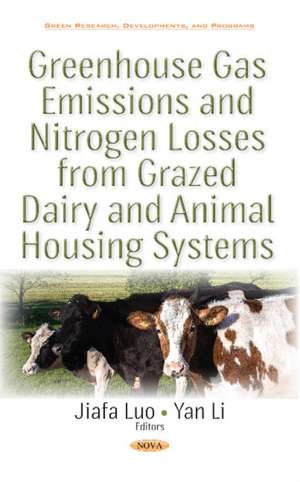Greenhouse Gas Emissions & Nitrogen Losses from Grazed Dairy & Animal Housing Systems
Editat de Jiafa Luo, Yan Lien Limba Engleză Hardback – mai 2017
Preț: 688.93 lei
Preț vechi: 883.69 lei
-22% Nou
Puncte Express: 1033
Preț estimativ în valută:
131.87€ • 143.29$ • 110.84£
131.87€ • 143.29$ • 110.84£
Carte disponibilă
Livrare economică 31 martie-14 aprilie
Preluare comenzi: 021 569.72.76
Specificații
ISBN-13: 9781536111002
ISBN-10: 1536111007
Pagini: 150
Dimensiuni: 155 x 230 x 16 mm
Greutate: 0.36 kg
Editura: Nova Science Publishers Inc
Colecția Nova Science Publishers Inc
ISBN-10: 1536111007
Pagini: 150
Dimensiuni: 155 x 230 x 16 mm
Greutate: 0.36 kg
Editura: Nova Science Publishers Inc
Colecția Nova Science Publishers Inc
Cuprins
Preface; Off-Grazing Animal Confinement Facilities & Their Use in New Zealand; Gaseous Emissions from Dairy Manure Collection in Animal Confinement Facilities; Gaseous Emissions from Dairy Manure Storage; Gaseous Emissions & Land Applications of Slurries & Solid Manures; Dietary Manipulation as a Tool for Mitigating Nitrous Oxide Emissions; Optimal Cattle Manure Application Rates to Maximise Crop Yield & Minimise Risk of Nitrogen Loss to the Environment; A Review of the Life Cycle Assessment of Off-Grazing Technologies; The Estimated Greenhouse Gas Emissions from Different Types of Housed/Restricted-Grazing Systems Used during the Winter in Southland & Waikato, New Zealand, Using Life Cycle Assessment; A Review of the Cost-Effectiveness of Grazing-Off Practices; Housed Versus Restricted Winter Grazing Systems: A Cost Analysis in Southland & Waikato, New Zealand; Index.
